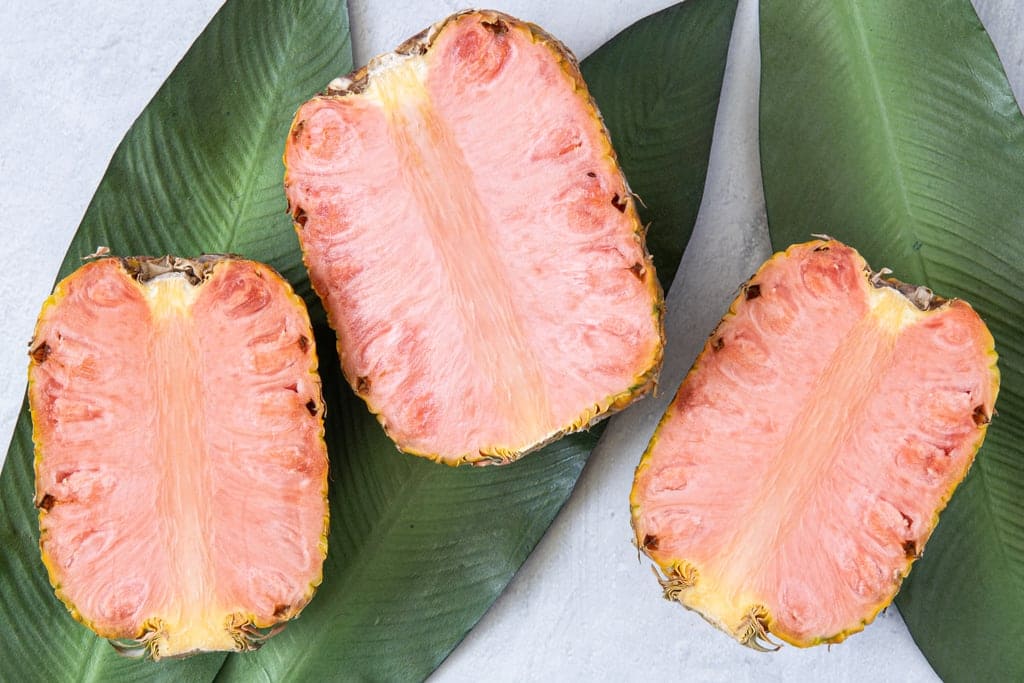Picture this: You’re hosting a dinner party and slice into what appears to be an ordinary pineapple. Your guests gasp as you reveal flesh the color of a sunset—vibrant pink that looks almost too beautiful to eat. Welcome to the world of pink pineapples, where cutting-edge science meets tropical indulgence.
If you’ve been scrolling through social media lately, you’ve probably spotted these rosy-hued fruits taking over Instagram feeds and TikTok videos. But pink pineapples aren’t just a pretty face—they represent a fascinating intersection of agricultural innovation, consumer psychology, and genuinely delicious fruit.
Whether you’re curious about the science, skeptical about the price, or simply wondering if they taste as good as they look, this guide will give you everything you need to know about the fruit that’s revolutionizing our relationship with tropical produce.
The Sweet Science: How Pineapples Turn Pink
The secret behind pink pineapples isn’t food coloring or fancy processing—it’s actually about what doesn’t happen during their development. Every pineapple starts life with lycopene, the same red pigment that gives tomatoes their vibrant color and watermelons their rosy blush.
In traditional yellow pineapples, an enzyme called lycopene beta-cyclase converts this pink lycopene into beta-carotene, which creates the familiar golden color we associate with ripe pineapples.
Scientists at Del Monte discovered they could essentially “turn off” this color-changing enzyme through genetic modification. Using a technique called RNA interference, they introduced genes that prevent the cell from producing the color-converting enzyme.
By reducing the activity of lycopene beta-cyclase, they created pineapples that retain their natural pink pigments instead of converting them to yellow. The result? Fruit that’s naturally pink throughout, with higher concentrations of antioxidant-rich lycopene.
The genetic modifications are remarkably precise—only three genes were altered, and none affect the safety or basic nutritional profile of the fruit.
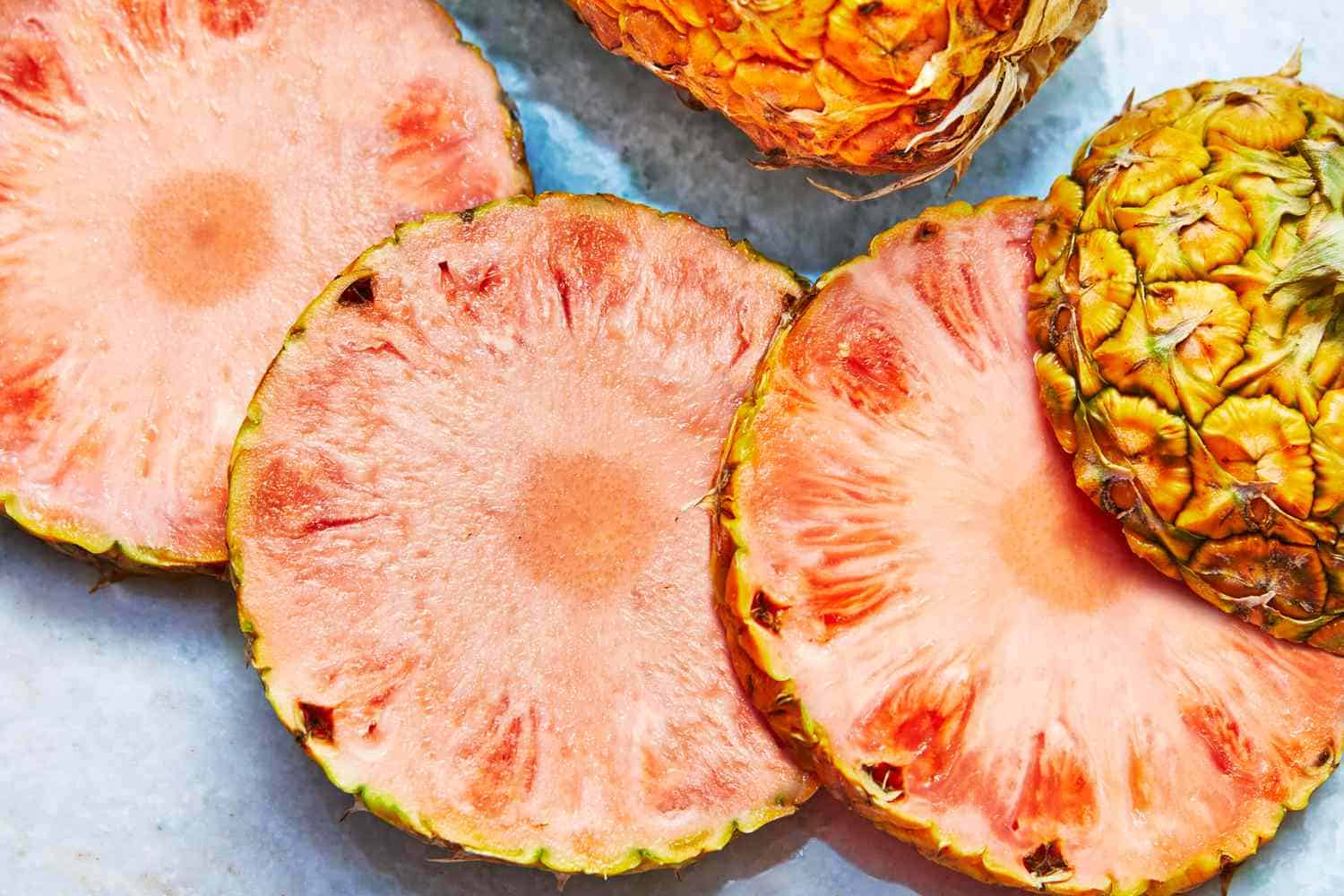
The FDA conducted extensive safety evaluations and confirmed these pineapples are as safe and nutritious as their yellow cousins, stating there are “no unresolved safety or regulatory questions” about the pink-fleshed fruit.
👉 Find out What Is Yellow Watermelon? Taste, Benefits & Varieties
What Do Pink Pineapples Actually Taste Like?
Here’s where pink pineapples get really interesting. Nearly everyone who tries them reports the same experience: they’re noticeably sweeter and less acidic than traditional pineapples. Many describe the flavor as having “candy-like aromatics” with notes reminiscent of pink Starburst candy—but in the best possible way.
Perhaps most remarkably, pink pineapples seem to have reduced levels of bromelain, the enzyme responsible for that familiar mouth-tingling sensation you get from eating fresh pineapple.
You know that slightly burning feeling that makes you want to rinse your mouth after enjoying a particularly juicy slice? Most people report significantly less of that discomfort with pink varieties.
I remember my first encounter with a pink pineapple at a farmer’s market in California. The vendor, a weather-beaten gentleman who’d been selling fruit for thirty years, handed me a sample with a knowing smile. “This’ll change how you think about pineapples,” he said.
He was right—the sweetness was immediate and clean, without that sharp acidic bite that sometimes makes you wince. It was like tasting the platonic ideal of what pineapple should be.
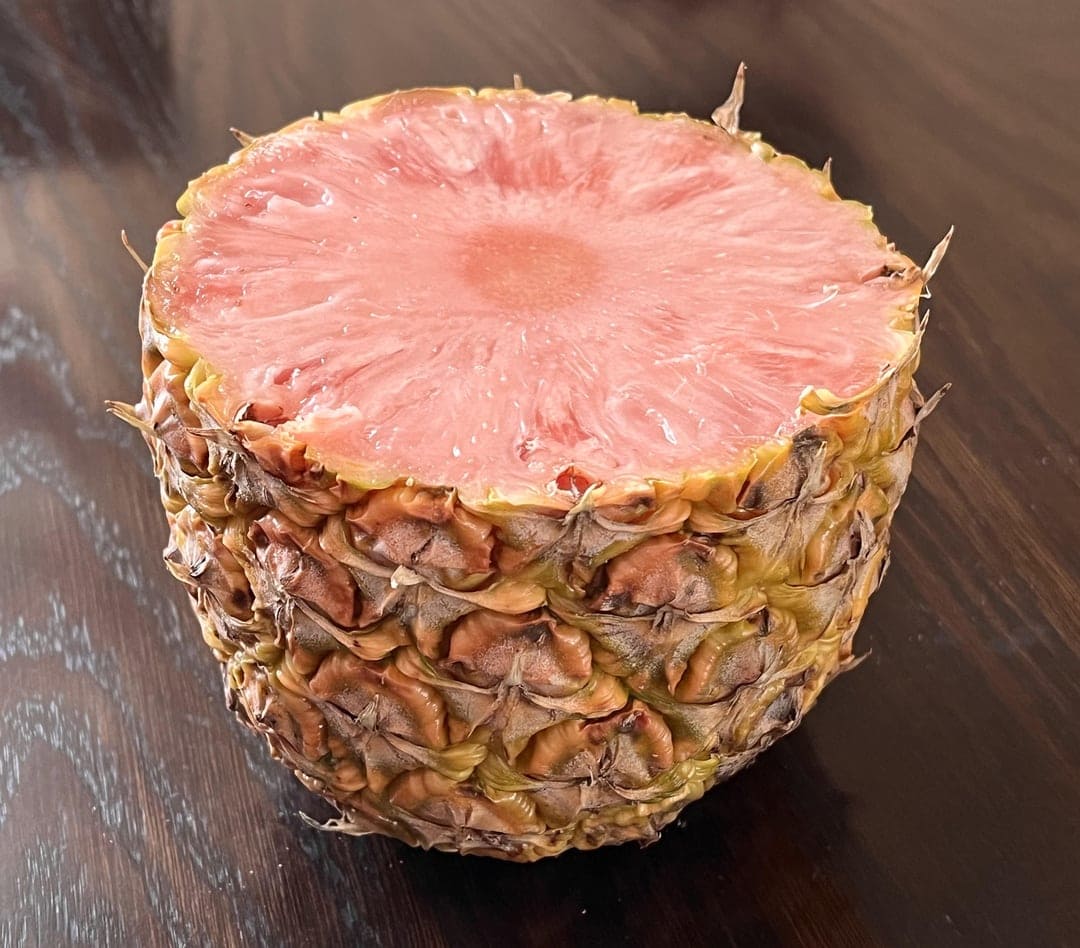
The consensus among taste testers is clear: if you enjoy the flavor of traditional pineapple but wish it were sweeter and gentler on your palate, pink pineapples deliver exactly that experience.
Nutritional Profile and Health Benefits
Pink pineapples pack the same essential nutrients as their yellow counterparts, with some enhanced benefits thanks to their higher lycopene content.
Like all pineapples, they’re excellent sources of vitamin C—one serving provides well over your daily requirement, supporting immune function and collagen production. They also contain meaningful amounts of manganese, important for bone health and wound healing, plus smaller amounts of thiamin, vitamin B6, and folate.
The standout nutritional advantage lies in their lycopene concentration. This powerful antioxidant, which gives the fruit its pink color, has been studied for its potential cardiovascular benefits and role in reducing oxidative stress.
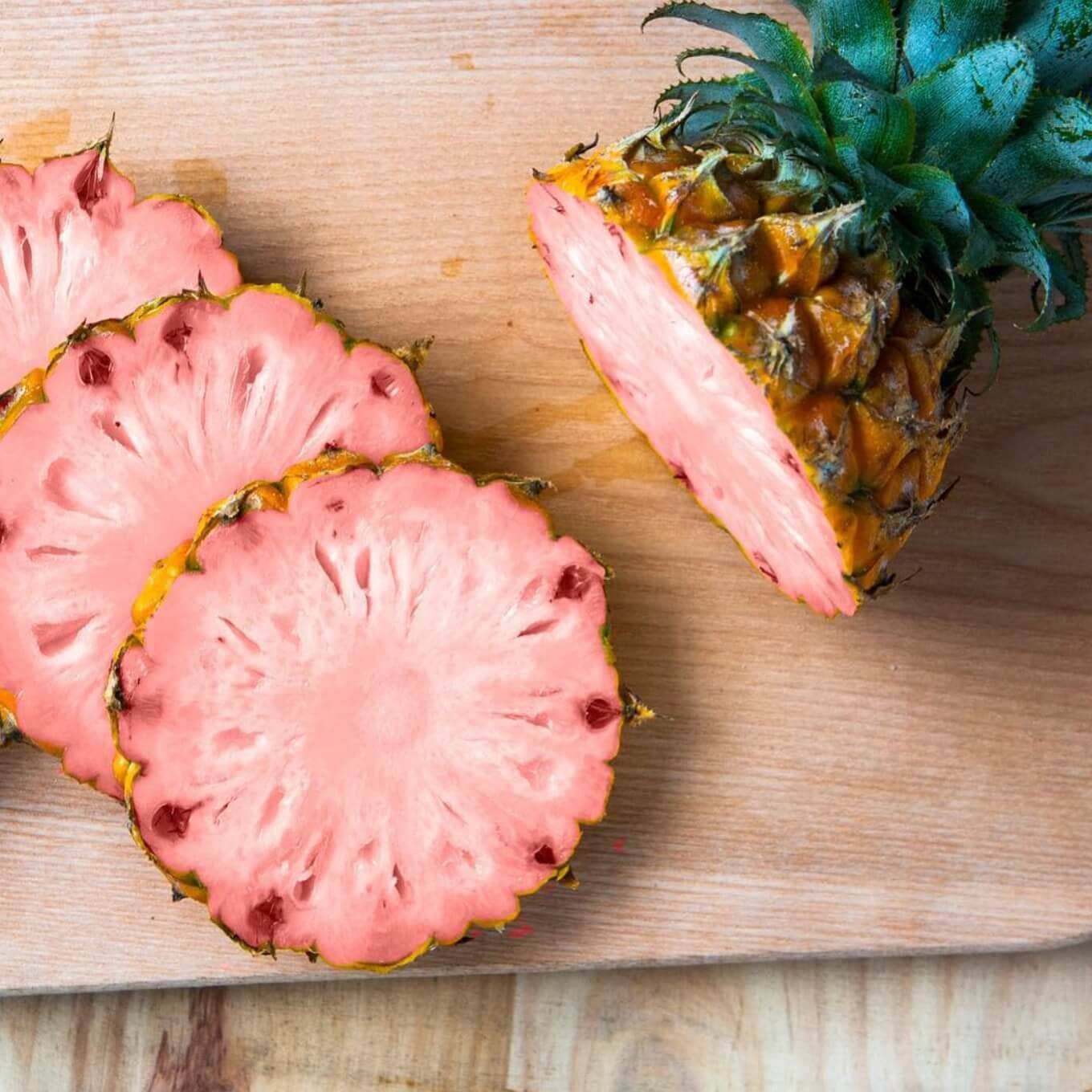
While Del Monte doesn’t make specific health claims about their pink pineapples, the presence of lycopene alongside traditional pineapple nutrients creates an interesting nutritional profile.
Pink pineapples also retain bromelain, though in apparently reduced amounts compared to yellow varieties. This group of anti-inflammatory enzymes aids protein digestion and may help reduce inflammation throughout the body.
The fiber content supports digestive health, while the natural fruit sugars provide quick energy without the crash associated with processed sweets.
From Laboratory to Luxury: The 16-Year Journey
The story of pink pineapples begins in 2005, when Del Monte’s research team embarked on what would become a decade-and-a-half journey of agricultural innovation.
Originally motivated by consumer interest in antioxidant-rich foods, scientists weren’t necessarily trying to create a pink pineapple—they were exploring ways to boost the nutritional profile of existing varieties.
The development process required extraordinary patience. Pineapples take approximately two years to mature, meaning each iteration of testing required multiple growing seasons. Del Monte tested four complete generations of plants between 2010 and 2014 alone, carefully evaluating everything from taste and texture to appearance and shelf life.
The regulatory journey proved equally complex. The Costa Rican government approved cultivation in 2011, recognizing the potential economic benefits while ensuring environmental safety. The USDA provided import approval in 2013 after determining the modified pineapples posed no plant pest risk.
Finally, the FDA completed its voluntary safety consultation in 2016, though this wasn’t legally required—Del Monte pursued it to provide additional consumer confidence.
This extensive timeline explains why pink pineapples command premium prices—the development costs alone represent a massive investment that needs to be recouped through sales.
Sustainable Farming: The Environmental Angle
One aspect that often gets overlooked in discussions about pink pineapples is Del Monte’s approach to sustainable cultivation. The farms in Costa Rica’s south-central region where these fruits are grown achieved carbon-neutral certification in 2015 through SCS Global Services.
This means the farming operations don’t contribute net greenhouse gases to the atmosphere—a significant achievement in commercial agriculture.
The crown removal that prevents home cultivation actually serves a dual purpose. Beyond protecting Del Monte’s intellectual property, these crowns are replanted to grow the next generation of pink pineapples, creating a closed-loop system that reduces waste and eliminates the need for new planting material.
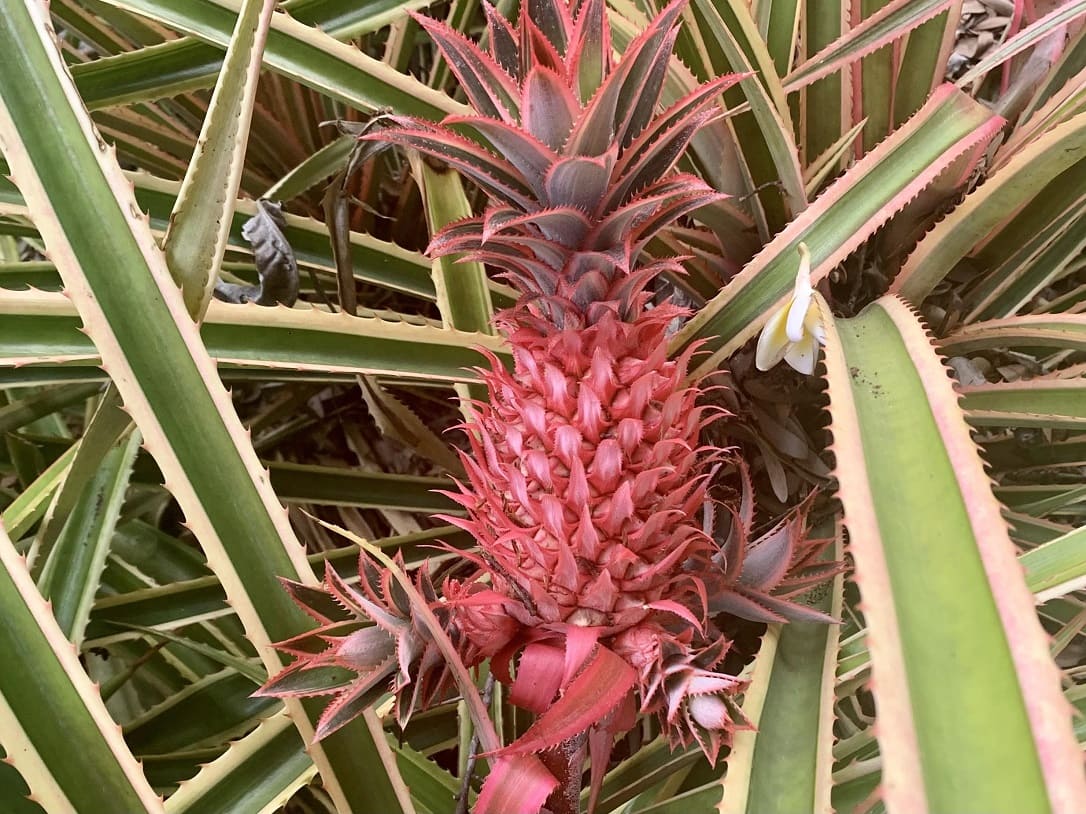
The volcanic soil and tropical climate of the Costa Rican growing region provide ideal conditions that minimize the need for synthetic inputs.
This sustainability focus addresses some criticisms about luxury fruit production. While the high price point raises questions about food equity, the environmental stewardship demonstrates that agricultural innovation can incorporate responsible practices.
👉 Here’s How to Grow White Strawberries: Pineberry Growing Guide & Care Tips
Geographic Limitations: Why Only North America?
Currently, pink pineapples are only available in the United States and Canada, with Hawaii being the sole exception due to state restrictions on pineapple imports. This limited availability stems from regulatory requirements rather than shipping constraints.
Each country where genetically modified foods are sold requires separate approval processes. Del Monte has focused on North American markets first, likely due to regulatory familiarity and consumer acceptance of GMO products.
Expanding to European or Asian markets would require navigating different regulatory frameworks, some of which are more restrictive regarding genetically modified organisms.
This geographic limitation actually contributes to the premium pricing and exclusivity factor. Until Del Monte pursues broader international approvals, pink pineapples remain a uniquely North American novelty.
The Price Reality: From $2 to $50
Perhaps nothing generates more discussion about pink pineapples than their price point. The range is genuinely staggering, from lucky finds at discount fruit stands for $2 to premium online retailers charging $50 per fruit.
Most major supermarkets that carry them price pink pineapples between $10-$15. Costco has been spotted selling them for $10.99, while specialty chains often charge closer to $15.
Direct-to-consumer sales through Del Monte’s website and specialty fruit retailers typically run $29-$50, often including decorative packaging and certificates of authenticity. Occasionally, discount fruit vendors or overstock sales offer them for $2-$6, though these opportunities are rare.
The price premium exists for several reasons beyond development costs. Pink pineapples are grown exclusively on Del Monte farms in Costa Rica, creating natural supply limitations. Each fruit is hand-harvested and carefully packaged, adding labor costs.
Most importantly, Del Monte has positioned these as luxury items rather than everyday fruit, targeting consumers willing to pay for novelty and premium quality.
Regional pricing variations tend to favor West Coast locations and areas with large Latin American populations, possibly due to proximity to shipping routes from Costa Rica.
Smart Shopping and Storage Strategies
Finding pink pineapples requires some strategy, but they’re becoming increasingly available. Your best bet starts with calling ahead to specialty grocery stores—many will special-order them if you ask. Chain stores like Wegmans, Hy-Vee, and select Kroger locations have carried them, though availability varies by season and region.
For the best value, avoid premium online retailers unless you’re purchasing for a special occasion. The $50 versions often come with elaborate packaging that’s perfect for gifts but unnecessary for personal consumption.
Instead, check with local stores during peak shipping seasons, typically late fall through early spring, when prices tend to be most reasonable.
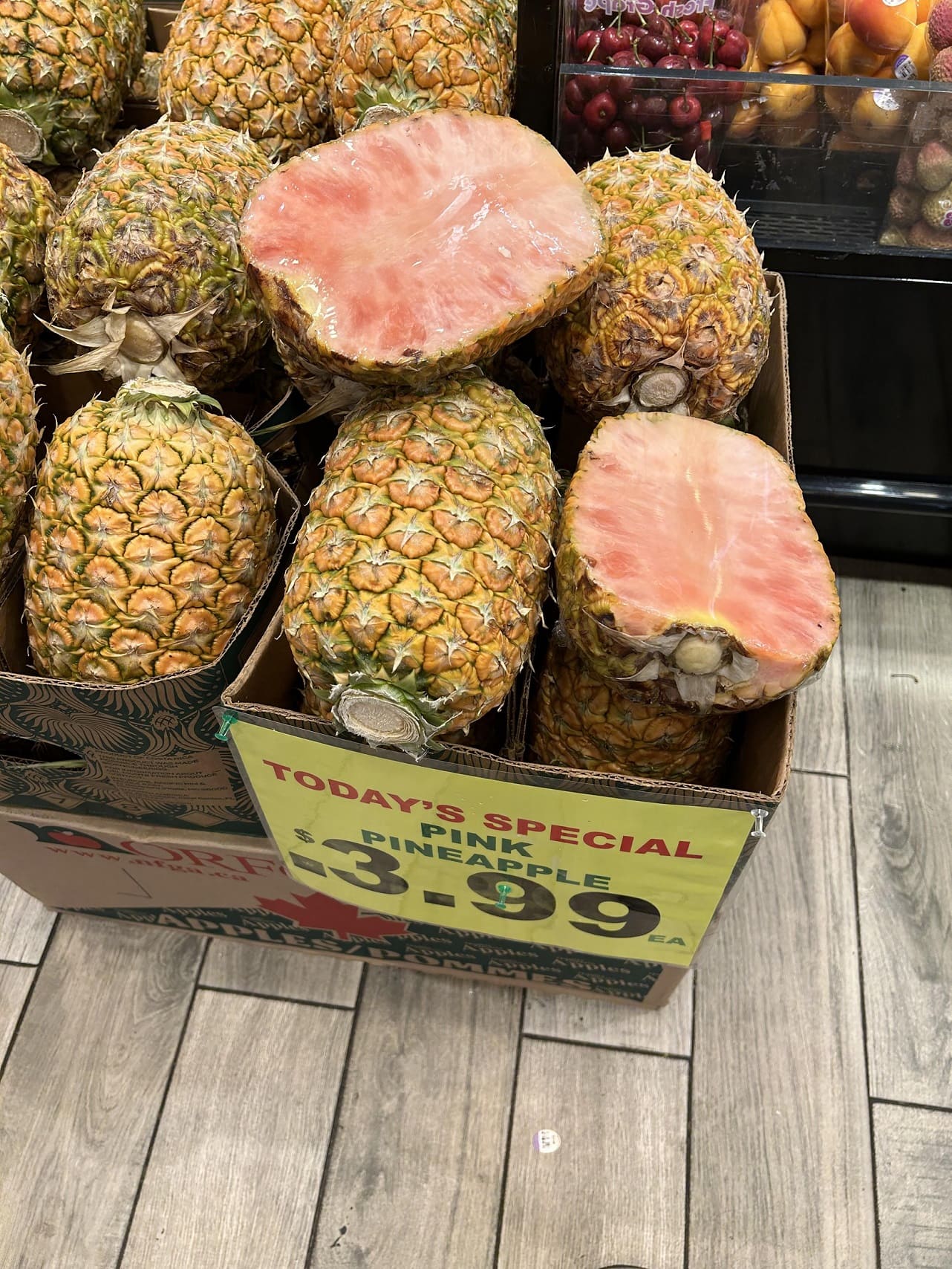
One important detail: pink pineapples always arrive without their crowns. Del Monte removes the tops both to facilitate shipping and to prevent home cultivation, since the company holds patents on the variety.
Once you’ve invested in a pink pineapple, proper handling ensures maximum enjoyment. Whole fruits keep 1-3 days at room temperature or 4-7 days refrigerated. Cut pieces should be consumed within 2-3 days for optimal freshness.
The same ripeness indicators apply as with regular pineapples: sweet aroma at the base, slight give when pressed, and golden color on the exterior.
Cooking and Serving: Making the Most of Pink
The visual impact of pink pineapple makes it perfect for entertaining, but its different characteristics also affect how it performs in recipes. The reduced acidity and higher sugar content mean it caramelizes more readily when grilled or roasted, creating deeper flavors without becoming overpowering.
However, this same quality means it can become overly sweet in dishes that already contain added sugars.
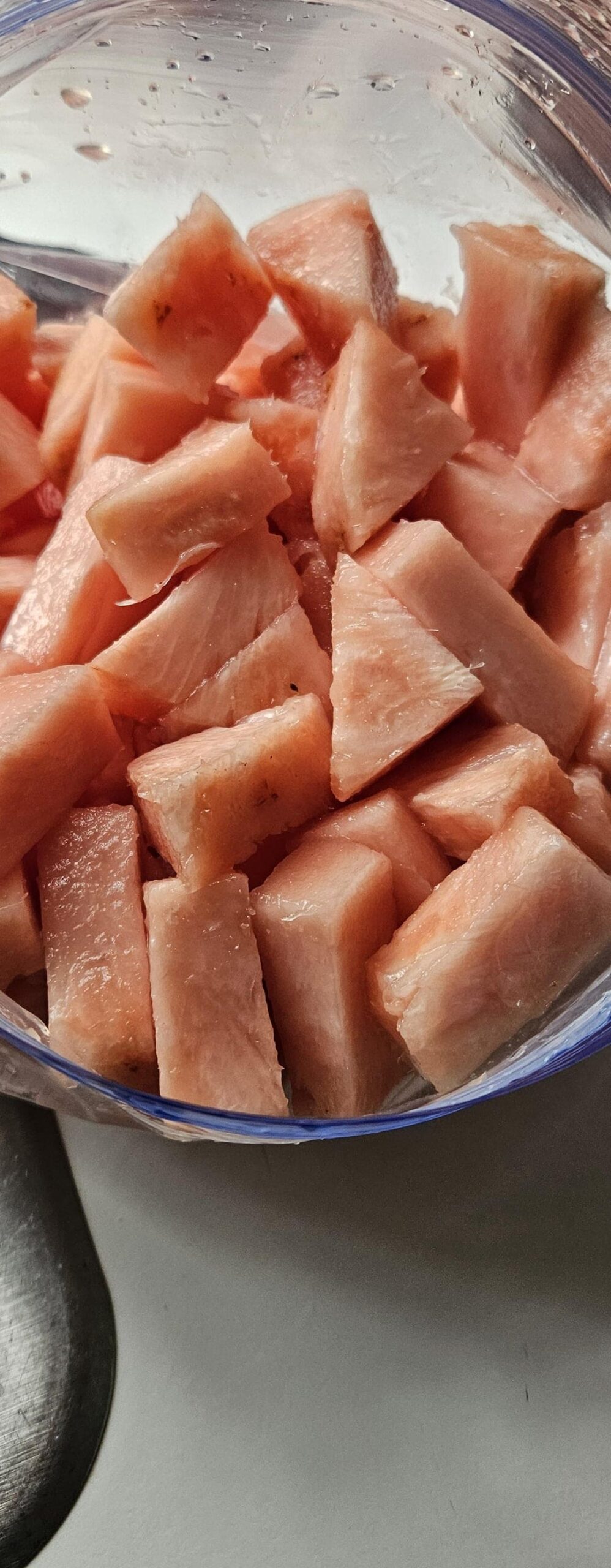
For fresh applications, slice and arrange on charcuterie boards where the pink color creates stunning contrast with cheeses and cured meats. Cube for fruit salads where it adds both color and sweetness balance. The juice retains its pink color, making it perfect for cocktails, smoothies, and agua frescas where visual impact matters.
When cooking with pink pineapple, reduce added sugars in recipes by about 25% to account for the enhanced natural sweetness.
The fruit works wonderfully in upside-down cakes, where the pink color creates an unexpected visual surprise, and in savory applications like grilled fish marinades, where the gentler acidity provides flavor without overwhelming delicate proteins.
For preservation, freeze chunks for future smoothies, or dehydrate slices for snacking. The concentrated sweetness of dried pink pineapple rivals any commercial fruit snack.
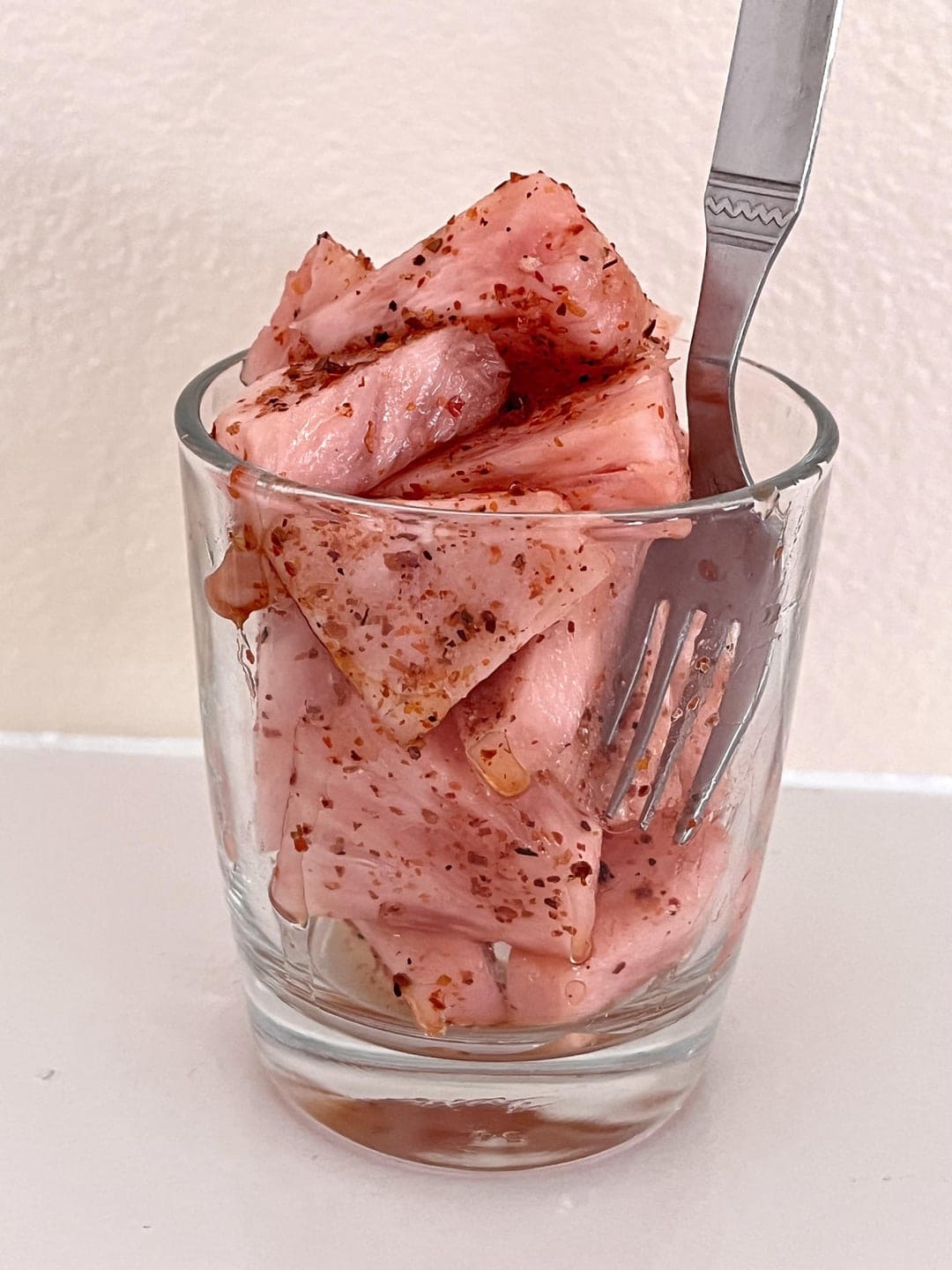
The Bigger Picture: Innovation or Indulgence?
Pink pineapples raise fascinating questions about agricultural innovation and consumer priorities. Critics point out the irony of spending millions developing luxury fruit while food insecurity persists globally. The timing of their 2020 launch—during a pandemic that doubled food insecurity rates—struck some as tone-deaf.
Yet supporters argue that agricultural innovation has always driven food security improvements. The techniques developed for pink pineapples could eventually be applied to create more nutritious, climate-resilient crops.
The marketing success demonstrates consumer appetite for novel foods, potentially encouraging further investment in agricultural research.
Standing in my local grocery store, comparing a $15 pink pineapple to the $4 yellow ones beside it, I found myself thinking about my grandmother’s stories of pineapples being so exotic that wealthy Europeans rented them for dinner parties.
Perhaps every generation has its luxury fruits that eventually become commonplace. Today’s Instagram-worthy pink pineapple might be tomorrow’s standard grocery aisle offering.
The reality lies somewhere between luxury and innovation. Pink pineapples represent genuine technological achievement wrapped in clever marketing. Whether that combination justifies the price depends entirely on your perspective and budget.
Frequently Asked Questions
- Are pink pineapples natural?
Pink pineapples are genetically modified to retain naturally occurring lycopene pigments. While the modification process is artificial, the pink color comes from compounds that naturally exist in pineapples.
- Do they taste significantly different from yellow pineapples?
Most people describe them as sweeter and less acidic, with reduced mouth-tingling effects. The core flavor is recognizably pineapple but enhanced.
- Are they worth the premium price?
This depends on your budget and priorities. For special occasions or fruit enthusiasts, many find them worthwhile. For everyday consumption, regular pineapples offer similar nutrition at much lower cost.
- Can I grow my own from seeds or cuttings?
No. Del Monte removes the crowns specifically to prevent home cultivation, and pineapples don’t typically produce viable seeds.
- Are they available year-round?
Yes, but availability varies by location and retailer. They’re more commonly found during peak shipping seasons.
- Are they safe for people with pineapple allergies?
Pink pineapples contain the same allergens as regular pineapples. If you’re allergic to traditional pineapples, avoid pink varieties as well.
The Sweet Verdict
Pink pineapples represent something fascinating in our modern food landscape—the intersection of scientific innovation, social media culture, and our eternal quest for new experiences. They’re simultaneously a triumph of agricultural engineering and a symbol of how marketing can transform perception.
Bottom line: If you’re curious about novel foods, enjoy premium fruit experiences, or want to impress guests with something genuinely unique, pink pineapples deliver on their promises.
They taste noticeably different from regular pineapples in ways most people find appealing, offer enhanced antioxidant content, and come from environmentally responsible farming practices. The price premium reflects both development costs and luxury positioning, making them more of an occasional treat than a pantry staple.
For the adventurous fruit lover, they’re worth trying at least once. For budget-conscious shoppers, stick with traditional varieties unless you find one of those rare discount opportunities. Either way, pink pineapples have earned their place in the conversation about where food innovation is heading.
Ready to join the pink pineapple movement? Start by calling your local specialty grocery stores to check availability and pricing.
And when you do take that first bite of rose-colored tropical sweetness, take a moment to appreciate the decade and a half of scientific work that made it possible—then share that gorgeous cross-section on Instagram, because some fruits are just meant to be shown off.
